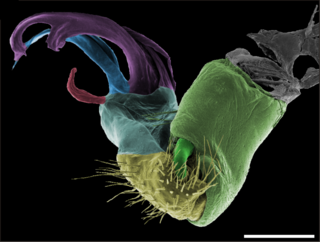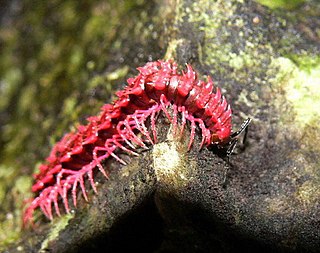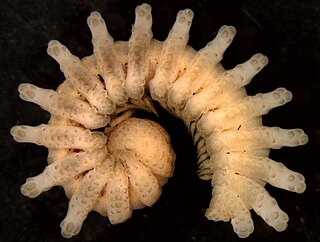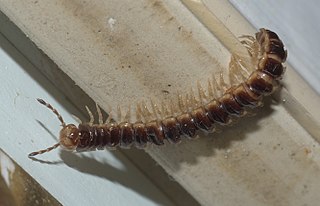
Gonopods are specialized appendages of various arthropods used in reproduction or egg-laying. In males, they facilitate the transfer of sperm from male to female during mating, and thus are a type of intromittent organ. In crustaceans and millipedes, gonopods are modified walking or swimming legs. Gonopods may be highly decorated with elaborate structures which may play roles in sperm competition, and can be used to differentiate and identify closely related species. Gonopods generally occur in one or more pairs, as opposed to the single (un-paired) reproductive organs such as the aedeagus of insects or the penis of harvestmen.

Harpaphe haydeniana, commonly known as the yellow-spotted millipede, almond-scented millipede or cyanide millipede, is a species of polydesmidan ("flat-backed") millipede found in the moist forests along the Pacific coast of North America, from Southeast Alaska to California. The dark coloration with contrasting yellow-tipped keels warn of its ability to exude toxic hydrogen cyanide as a defense. Despite the various common names given the species, the coloration pattern, cyanide defense, and associated almond scent occur in other flat-backed millipedes around the world.

Desmoxytes, whose species are commonly known as the dragon millipedes, is a genus of millipedes of the family Paradoxosomatidae found in Southeast Asia. The genus was described by Ralph Vary Chamberlin in 1923, and reviewed by Sergei Golovatch and Henrik Enghoff in 1994. At least 18 species are known from to Malaysia, Myanmar, and Thailand. One species, D. planata, has also been observed in Sri Lanka, the Andaman Islands, Seychelles, Java, Great Coco Island, and Fiji; however, this species has expanded its range by being transported through human activity. Several species have only recently been discovered, and some have yet to be officially described.

Polydesmida is the largest order of millipedes, containing approximately 3,500 species, including all the millipedes reported to produce hydrogen cyanide (HCN).
Hylomus is a genus of millipede of the family Paradoxosomatidae found in southeast Asia.

Siphonophorida is an order of millipedes containing two families and over 100 species.

Callipodida is an order of millipedes containing around 130 species, many characterized by crests or ridges.

Orthomorpha is a genus of millipedes in the family Paradoxosomatidae containing approximately 50 species distributed in Southeast Asia.

Chordeumatida is a large order of millipedes containing some 1200 species with a nearly worldwide distribution. Also known as "sausage millipedes," they possess around 30 body segments behind the head as adults and reach about 25 mm (0.98 in) in length.

The greenhouse millipede, also known as the hothouse millipede, short-flange millipede, or garden millipede, is a species of millipede in the family Paradoxosomatidae that has been widely introduced around the world, and is sometimes a pest in greenhouses.
Orthomorpha coarctata, the long-flange millipede, is a widely introduced species of Polydesmidan millipede of the family Paradoxosomatidae. It is presumed native to Southeast Asia but due to transport by humans occurs in tropical and sub-tropical areas throughout the world, including the Hawaiian Islands, the West Indies, Gulf Coast of North America, and the Galápagos Islands.
Harpagomorpha is a genus of millipede in the family Paradoxosomatidae containing a single species, H. dentata, known from the Nilgiri mountains, Southern India. H. dentata was originally described by Swiss zoologist Johann Carl in 1932 under the name Orthomorpha dentata, and transferred to its own genus by Dutch zoologist C. A. W. Jeekel in 1980.

Haplodesmidae is a family of millipedes in the order Polydesmida. Species occur in East Asia, Southeast Asia, and Oceania, although some species have been introduced to the New world tropics. Species are small bodied, often with elaborate sculpturing on the tergites, and some species are capable of rolling into a near-complete ball.
Hylomus rhinoceros is an aposematic species of dragon millipede in the family Paradoxosomatidae. It is only known from Champasak and Sekong Provinces in southern Laos.

Chamberlinius is a genus of flat-backed millipedes in the family Paradoxosomatidae. There are five species; 3 of which occur only Taiwan, one only in the Ryukyu Islands of southeast Japan, and one occurring in both areas. Individuals are 25–37 mm (0.98–1.46 in) long and up to 5.5 mm wide, colored in pale yellow to brown, sometimes with dark brown markings on the anterior portion of body segments.

Boreohesperus is a genus of paradoxosomatid millipedes containing six species native to Western Australia. The name refers to the northwestern distribution in Australia, deriving from Boreas, Greek god of the North, and hesperus, Latin for "west".

Anoplodesmus is a genus of millipedes. It is one of the most species rich genera in the family Paradoxosomatidae, with over 40 described species distributed from India and Nepal to China and Southeast Asia, as well as the Mascarene Islands and Fiji.

Oxidus is a genus of flat-backed millipedes in the family Paradoxosomatidae. There are about nine described species in Oxidus.

Desmoxytes cervina, is a species of millipede in the family Paradoxosomatidae. It is known from Myanmar and Thailand.



















